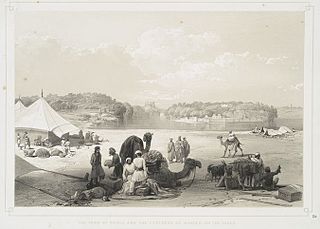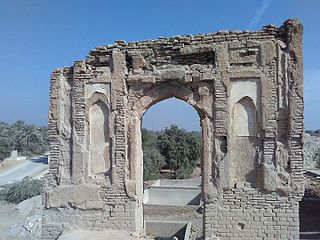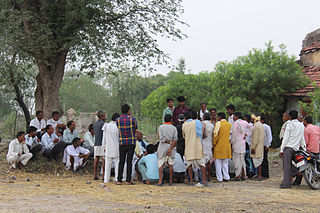Related Research Articles
Sangwan is a surname of the Jat people found in the Indian state Haryana and UttarPradesh.

Arora is a community of Punjab, comprising both Hindus and Sikhs. The name is derived from their native place Aror. In 712, the Arora people left Aror and started to settle in the cities of Punjab.
Charkhi Dadri is a city and the headquarters of Charkhi Dadri district in the Indian state of Haryana, about 90 km from the national capital Delhi. The town was made by joining the villages of Charkhi and Dadri after urban development. Charkhi Dadri is on NH 148B between Narnaul to Bathinda and NH 348B between Meerut to Pilani segment passing through the city.
Tyagi, originally called Taga, is a cultivator caste who claim Brahmin status. The landholding community is confined to Western Uttar Pradesh, Haryana, Delhi and Rajasthan. They are often considered the highest of the agricultural castes. During the British Raj, they changed their name from Taga to Tyagi, and began claiming Brahmin status. As of a 1990 report by the Backward Classes Commission, Government of Haryana, they were mostly engaged in farming. The Government of Haryana granted reservation to Tyagis along with five other castes in 2016. However, the Punjab and Haryana High Court shortly put a stay on the government's order.
A Khap is a community organisation representing a clan or a group of North Indian castes or clans. They are found mostly in northern India, particularly among the Village people of Haryana and Western Uttar Pradesh (Jats), but also amongst states like Rajasthan and Madhya Pradesh although historically the term has also been used among other communities. A Khap Panchayat is an assembly of Khap elders, and a Sarv Khap is an assembly of many Khap Panchayats.
Bhumihar, also locally called Bhuinhar and Babhan, is a Hindu caste mainly found in Bihar, the Purvanchal region of Uttar Pradesh, Jharkhand, the Bundelkhand region of Madhya Pradesh, and Nepal.

Aror or Alor or Arorkot is the medieval name of the city of Rohri. Aror once served as the capital of Sindh.
The Ghirth is an agricultural Indian caste found in the state of Himachal Pradesh in North India.

Chhipi is a caste of people with ancestral roots tracing back to India. These people are basically Rajputs and used to wear Kshatriya attire. These people were skilled in the art of war, Later people of this caste started doing printing work. They are found in the states of Gujarat, Rajasthan, Madhya Pradesh, Haryana, Delhi, Uttar Pradesh of India.
Malik is a surname deriving from the Arabic word malik, meaning "king" or "chieftain". The title "Malik" was granted to many Jats in India, and began to be used a surname in the 14th century. Malik is also found in Ror people of Haryana.
Gopa or Gop or Gope is a synonym of the Yadav (Ahir) caste. It is generally used as a title by the Ahir caste in the states of Bihar, Jharkhand and West Bengal of East India and even in Terai region of Nepal.
Chopra is a Punjabi Khatri and Haryanvi Ror surname. They belonged to the Barah-Ghar / Bahri family-group of the Khatris, which also includes the clans of Dhawan, Kakkar, Kapoor, Khanna, Mehra, Malhotra, Sehgal, Seth, Tandon, Talwar, and Vohra.

Caste panchayats, based on caste system in India, are caste-specific juries of elders for villages or higher-level communities in India. They are distinct from village panchayats in that the latter, as statutory bodies, serve all villagers regardless of caste, although they operate on the same principles. A panchayat can be permanent or temporary.
The Jat people are a traditionally agricultural community in Northern India and Pakistan. Originally pastoralists in the lower Indus river-valley of Sindh, Jats migrated north into the Punjab region in late medieval times, and subsequently into the Delhi Territory, northeastern Rajputana, and the western Gangetic Plain in the 17th and 18th centuries. Of Hindu, Muslim and Sikh faiths, they are now found mostly in the Indian states of Punjab, Haryana, Uttar Pradesh and Rajasthan and the Pakistani provinces of Sindh and Punjab.

The Jat reservation agitation was a series of violent protests in February 2016 by the Jat people of North India, especially those in the state of Haryana, which "paralysed" the state for 10 days. The protestors sought inclusion of their caste in the Other Backward Class (OBC) category, which would make them eligible for affirmative action benefits. Besides Haryana, the protests also spread to the neighbouring states, such as Uttar Pradesh, Rajasthan, and the National Capital Region.
Brar is a surname, and a Jat clan from the Punjab region.
Chauhan is a surname of various Indian communities including the Lonia and Ror caste found in the Indian state Haryana, Uttar Pradesh and Bihar.

The Haryanvi people are an Indo-Aryan ethnic group native to Haryana in northern India. They speak Haryanvi, a central Indo-Aryan language related to Western Hindi, and other similar dialects such as Ahirwati, Mewati, Puadhi, Rangri, and Bagri. The term Haryanvi people has been used both in the ethnolinguistic sense and for someone from Haryana.
References
- ↑ "Social Groups of Uttar Pradesh: Gurjar, Ahirs, Yadav, Tomara Dynasty, Ror, Mughal, Jat People, Kayastha, Ranghar, Meo, Bhumihar, Bais Rajput: 9781156607022 - AbeBooks". www.abebooks.com. Archived from the original on 24 March 2023. Retrieved 24 March 2023.
- 1 2 Report of the Backward Classes Commission, 1990, Government of Haryana. Controller of Printing and Stationery. 1990. pp. 145, 146. Archived from the original on 26 March 2023. Retrieved 12 May 2019.
- 1 2 3 Singh, K. S. (1998). India's Communities. Vol. 6. Anthropological Survey of India. p. 3054. ISBN 978-0-19-563354-2. Archived from the original on 24 December 2021. Retrieved 31 December 2019.
- ↑ "Ex-Army officer appointed administrator of Ror Mahasabha". Business Today . PTI. 17 August 2019. Archived from the original on 12 April 2022. Retrieved 12 April 2022.
- 1 2 Singh, Kumar Suresh (1992). People of India: Haryana. Anthropological Survey of India. p. 425. ISBN 978-81-7304-091-7.
Sangwan, Dahiya, Malik, Lather, etc, are also found among the Jats
- 1 2 3 4 5 6 7 Singh, K. S. (1996). Communities, Segments, Synonyms, Surnames and Titles. Anthropological Survey of India. ISBN 978-0-19-563357-3.
- ↑ Mehla, Ishwar Singh (22 June 2023). An Anthology On The Ror Caste. Notion Press. ISBN 979-8-88975-967-6.
- ↑ "Manoj's Mantra: Never back down in face of adversity". Business Standard . 14 April 2018. Archived from the original on 22 November 2021. Retrieved 22 November 2021.
- ↑ "नीरज चोपड़ा ने बताई अपनी जाति !! Neeraj Chopra cast". YouTube . Feed 4 Mind. 23 November 2021. Archived from the original on 31 January 2022. Retrieved 23 March 2022.